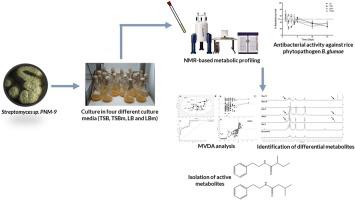Microbiological Research ( IF 6.1 ) Pub Date : 2020-06-03 , DOI: 10.1016/j.micres.2020.126507 Luz A Betancur 1 , Abel M Forero 2 , Diana M Vinchira-Villarraga 2 , Juan D Cárdenas 2 , Adriana Romero-Otero 2 , Fernanda O Chagas 3 , Monica T Pupo 3 , Leonardo Castellanos 2 , Freddy A Ramos 2

|
Actinobacteria are the major source of bioactive secondary metabolites and are featured in the search for antimicrobial compounds. We used nuclear magnetic resonance (RMN)-metabolic profiling and multivariate data analysis (MVDA) to correlate the metabolites’ production of Streptomyces sp. PNM-9 from the algae Dictyota sp. and their biological activity against the rice phytopathogenic bacteria Burkholderia spp. The compounds 2-methyl-N-(2′-phenylethyl)-butanamide (1) and 3-methyl-N-(2′-phenylethyl)-butanamide (2) were identified through MVDA and 2D NMR experiments in the organic extract of a 15-days LB media culture of Streptomyces sp. PNM-9. Compounds 1 and 2 were isolated and their structures confirmed by one- and two-dimensional NMR and mass spectrometry (MS) data. Compounds 1 and 2 were active against the rice pathogenic bacteria Burkholderia glumae (ATCC 33,617) displaying minimal inhibitory concentration (MIC) values of 2.43 mM and 1.21 mM, respectively. The metabolomics-guided approach employing NMR-metabolic profiling was useful for marine microbial bioprospecting and suggested Streptomyces sp. PNM-9 strain and its compounds as a potential control against phytopathogenic bacteria.
中文翻译:

基于NMR的代谢谱分析,以追踪海洋菌株Streptomyces sp。培养物中抗植物病原性化合物的产生。PNM-9。
放线菌是生物活性次生代谢产物的主要来源,在寻找抗菌化合物中具有特色。我们使用核磁共振(RMN)-代谢谱和多元数据分析(MVDA)来关联链霉菌sp的代谢产物的产生。来自藻类Dictyota sp。的PNM-9 。及其对水稻植物致病菌伯克霍尔德氏菌的生物学活性。通过MVDA和2D NMR实验在有机提取物中鉴定了化合物2-甲基-N-(2'-苯乙基)丁酰胺(1)和3-甲基-N-(2'-苯乙基)丁酰胺(2)。链霉菌15天的LB培养基培养。PNM-9。化合物1分离出1和2,并通过一维和二维NMR和质谱(MS)数据确认其结构。化合物1和2对水稻致病细菌小球藻伯克霍尔德菌(ATCC 33,617)具有活性,分别显示最小抑菌浓度(MIC)值为2.43 mM和1.21 mM。代谢组学指导的采用NMR代谢谱分析的方法可用于海洋微生物生物勘探,并建议使用链霉菌。PNM-9菌株及其化合物可作为对抗植物病原菌的潜在控制。











































 京公网安备 11010802027423号
京公网安备 11010802027423号